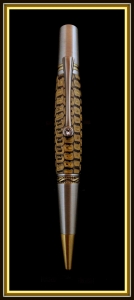George - Maybe you'd like to clarify what you mean by low and high speed? I had my lathe set to around 1400RPM and my angle grinder was set in the middle of the variable speed range. I didn't consider reducing the speed of either to reduce tear out. The flap disc works well enough and certainly is handy when turning a fragile blank but it isn't as much fun as turning with a conventional tool. Wham bam and you're done!
Certainly my friend,
The speed of the angle grinder is not as important as the lathe speed, in fact, most of the small grinders have no variable speed and they speed is fast and that is good, the faster the better however, on the lathe, high speeds shake things out, the 1,400 RPM is not too fast but you could go slower, how slow? anything from 400 to 1,000 is sufficient.
You can test the best turning speed in these cases but, soaking a pen blank with water and put it on the lathe, start with the lowest speed (this is easy with variable speed lathes, and watch for any "spills" of water being ejected from the wood, the ideal speed is the highest speed before the water start to come out of the blank.
I have had many reports from the guys that turn regularly some of my most fragile blanks where pieces can fly out that they seemed to have lots of problems with before, particularly with bits coming off however, when I suggested a much lower speed on the lathe, they reported back to me that, they problem was solved.
I know that works because I tested it many times before, I never suggest anything unless I have tested it myself however, there can be some variables that can produce a different/not as expected results.
Hope this answers your question.
PS: These corn blanks are one of the type blanks where I would strongly suggest to soak the drilled hole with plenty of super thin CA, I mean give it plenty to allow the CA to penetrate into the corn/kernel base, which is basically what will be left behind after turning it to size/shape, that works wonders.
Cheers
George


